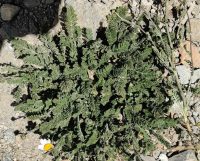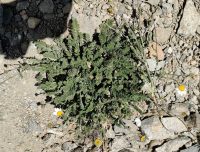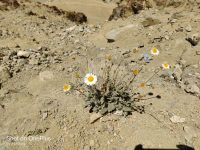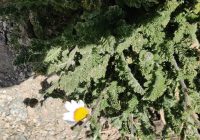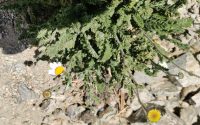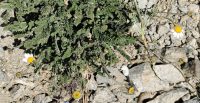|
Pyrethrum pyrethroides (Kar. & Kir.) B.Fedtsch. ex Krasch. (syn:Chrysanthemum artemisiifolium Klatt; Chrysanthemum pyrethroides (Kar. & Kir.) B.Fedtsch.; Chrysanthemum richteria Benth. ; Chrysanthemum richteria Benth. ex Hook.f. ; Pyrethrum pyrethroides (Kar. & Kir.) B.Fedtsch.; Richteria pyrethroides Kar. & Kir.; Tanacetum pyrethroides (Kar. & Kir.) Muradyan; Tanacetum pyrethroides (Kar. & Kir.) Muradyan; Tanacetum pyrethroides (Kar. & Kir.) Sch.Bip.) as per GBIF;
.
Pyrethrum pyrethroides (Kar. & Kir.) B.Fedtsch. ex Krasch., in Trudy Bot. Inst. Akad. Nauk SSR, I, 1: 176 (1933). (syn. Chrysanthemum pyrethroides (Kar. & Kir.) B.Fedtsch.; Chrysanthemum richteria Benth.; Tanacetum pyrethroides (Kar. & Kir.) Podlech; Tanacetum pyrethroides (Kar. & Kir.) Muradyan; Tanacetum pyrethroides (Kar. & Kir.) Sch.Bip.) as per The Plant List Ver. 1.1; . Common name: Himalayan Chrysanthemum • Ladakhi: སེརཔན Serpan
.
ID needed for Leh Flowers 25a&b – efloraofindia | Google Groups : 9 posts by 6 authors. Attachments (2) May be Tanacetum stoliczkae (C.B. Clarke) Khan Something new for me … can you kindly give the altitude of the place it was growing, if you have it Waldheimia tomentosa? Waldheimia tomentosa (syn: Allardia tomentosa) has white tomentose leaves, not in this plant. I think this is Chrysanthemum pyrethroides Yes finally perhaps … is right Here it is, I forgot to upload earlier. Attachments (1) Chrysanthemum pyrethroides This appears to be closer to the images of Spathipappus griffithii (C.B.Clarke) Tzvelev synonym of Tanacetum griffithii (C.B.Clarke) Muradyan as below: Pl. have a look.
Images of Pyrethrum pyrethroides are a bit common on net. Pl. have a look at the following links:
http://www.track.kz/flora.htm
In view I am leaning more towards Tanacetum griffithii (C.B.Clarke) Muradyan Yes, I am currently in agreement with such thinking. GBIF gives Type specimen links of Pyrethrum pyrethroides (Kar. & Kir.) B.Fedtsch. ex Krasch. (syn:Chrysanthemum artemisiifolium Klatt; Chrysanthemum pyrethroides (Kar. & Kir.) B.Fedtsch.; Chrysanthemum richteria Benth. ; Chrysanthemum richteria Benth. ex Hook.f. ; Pyrethrum pyrethroides (Kar. & Kir.) B.Fedtsch.; Richteria pyrethroides Kar. & Kir.; Tanacetum pyrethroides (Kar. & Kir.) Muradyan; Tanacetum pyrethroides (Kar. & Kir.) Muradyan; Tanacetum pyrethroides (Kar. & Kir.) Sch.Bip.) as below: Link 1 (Chrysanthemum artemisiifolium Klatt)
Link 2 (Richteria pyrethroides Kar. & Kir.)
If we go by the type specimen at Gbif, our posted plant is Pyrethrum pyrethroides (Kar. & Kir.) B.Fedtsch. ex Krasch. OK I note from the field notes for C.artemisifolium that it has been incorrectly included within Xizang (Tibet) as is a Schlagintweit collection from Zanskar (Padam being the capital) – compounded by use by British of “Western Tibet”, most of which was never in ‘Tibet’ proper (at least not in recent centuries). I have seen this in other US herbaria. .
A number of nomenclatural and taxonomic changes have taken place with this plant. There are two species to consider, although ‘Flowers of the Himalaya’ incorrectly say only 1 (they used the genus Chrysanthemum).
Stewart lists Chrysanthemum pyrethroides as very common in the dry inner mountains. He also listed C.griffithii.
At one point these species were included within the genus Pyrethrum (Stewart lists these names as synonyms).
He observes about Chrysanthemum and Tanacetum, “The specialists differ so much in their treatment of this assemblage of plants that in making a check-list it is difficult to know who to follow. Rechinger places Pyrethrum and Tanacetum under Chrysanthemum. Kitamura does the same. Hooker placed the pretty rayed types in Chrysanthemum and the disciform headed plants with small flowers., usually corymbose, he placed in Tanacetum. Clapham says that Tanacetum differs in the apparent absence of ray florets, the marginal female florets having ligules so short they appear +/- tubular like hermaphrodite central florets”……
I am no specialist not taxonomist! I really how troublesome and confusing all these changes are for most people.
Anyhow, Dickore & Klimes, included these species under Tanacetum – they have 7 other species, which look very different to these!
So can we readily tell these two species apart? It is complicated by, as Stewart says, there is a great difference in the amount of pubescence in Tanacetum pyrethroides (which he knew as C.pyrethroides) – some being sub-glabrous, others white hoary.
For the present, I am uncertain how to distinguish between T.pyrethroides and T.griffithii but think your plant must surely be one of these. Forgot to mention that just to complicate things further, the genus Richteria is also applied to these plants. Thanks, …, With great difficulty I could find two images of Spathipappus griffithii (C.B.Clarke) Tzvelev synonym of Tanacetum griffithii (C.B.Clarke) Muradyan as below:
Pl. have a look.
Images of Pyrethrum pyrethroides are a bit common on net. Pl. have a look at the following links:
http://www.track.kz/flora.htm
In view I am leaning more towards Tanacetum griffithii (C.B.Clarke) Muradyan Thanks for sending these – you are so much better than me at tracking these images/links down. We can all contribute in different ways. So encouraging for me to have input from others – working alone (i.e. not at an institution/botanic garden) has its downsides. In the past I visited the Natural History Museum in London’s herbarium quite a number of times. Arthur Chater, co-author of ‘Enumeration of the Flowering Plants of Nepal’ was so welcoming and helpful – the herbarium collections for much of the Himalaya are better/different to the material at Kew. So useful to compare images but we must always be cautious. Just because something has been named as such on an internet site does not mean it can be relied upon. Mistakes can and often are made.
Same applies to traditional printed illustrations/plant guides. I have even spotted a few within ‘Flowers of the Himalaya’. One of the sites has some glaring mistakes- like a Primula labelled as a Myosotis!
It is so helpful for me to have had a copy of Stewart’s ‘Annotated Catalogue of the Vascular Plants of Pakistan & Kashmir’ to-hand (indeed Stewart’s final copy with his handwritten annotations to it) – though did involve visiting him in California! I also, through his student at Gordon College, who went on to be Professor Nasir got copies of some of the early family revisions of ‘Flora of Pakistan’ – which are better than what is available through eflora of Pakistan – the revisions/treatments inevitably vary in quality/reliability.
Stewart, whilst not a professional taxonomist, generally commented intelligently and wisely, so his thoughts can almost always be relied upon. As you rightly say, we are all fallible…..
And with the work of Dickore and Klimes (what a loss to the study of Ladakh flora) providing a more up-to-date checklists -though as you know as soon as anything is completed, it is out-of-date. But makes a difference having trustworthy references, rather than checklists missing a significant proportion of species present and littered with errors.
Though having sufficient knowledge/expertise to assess what works can be relied upon, is not accumulated quickly.
It also helps to have input from those who are more particular/able at proof-reading and checking the fine detail, as I am prone to typing and other errors. I think my strengths lie in an overall flora preparation, whilst others are more suited/skilled at the fine-detail of taxonomic revisions.
Returning to the griffithii/pyrethroides matter. I think there has been a mix-up in the past. IF the determination of the images from Tajikistan is correct (and those of Pyrethrum pyrethroides), then certainly the images taken on the way to Khardung La (unfortunately I have misplaced these and cannot trace them quickly) – and several other images I have from other sources, also within ‘Flowers of the Himalaya’, ‘Himalayan Plants Illustrated’ plus the FOI site, may be T.griffithii not T.pyrethroides – which fits in with what you are thinking.
Though as Stewart says of C.pyrethroides
“there is a great deal of difference in the amount of pubescence in this taxon, some are subglabrous while others are white hoary”.
Both Stewart and Dickore/Klimes list both species. It would be interesting to know what Dickore thinks – and have a specialist look into the matter.
It would be amusing if T.griffithii turns out to be “very common in the dry inner mountains”, rather than T.pyrethroides – which I
may yet to have seen images of in Ladakh?
I am feeling tired mentally again (and in much pain) so must take another break – so tiresome to have these health problems…. Finally we take it as Tanacetum griffithii (C.B.Clarke) Muradyan. I came across … suggestion of Tanacetum stoliczkae (.B.Clarke) R.Khan. At that time it was decided the photos were of C.pyrethroides.
This is an accepted name which gives a link to two pressed specimens at Kew – both of which have hand written comments by C.B.Clarke saying he had made mistakes identification-wise, which “got past” Hooker and thus presumably into ‘Flora of British India’. Note spelling at that time of C.stoliczkai Clarke
Clarke comments about misidentifying the specimen collected at Kargil; the other location marked on the first specimen is Patseo, Lahoul.
I have taken a look at Hooker’s FBI – he includes only two ‘species’ but remarks on similarity between C.stoliczkai and C.griffithii.
Khan’s name comes after Stewart’s Catalogue but Stewart does not include C.stoliczkai Clarke only C.stoliczkai Hk.f. (non Clarke)
as a synonym for C.griffithii.
There are links to:
This has been determined by Dickore
So how do these relate to T.griffithii?
The Plant List for Tanacetum does not have T.griffithii but does have T.richterioides
see: http://www.theplantlist.org/tpl/record/gcc-125471 but gives no synonyms nor pressed specimens at Kew but when one searches for Kew specimens, often out-of-date names are used, especially for 19th century specimens, so unless one knows the synonyms, they can be missed.
I had missed that Dickore & Klimes have T.stoliczkae in their check-list for Ladakh- so we now have ‘species’ to consider or perhaps ‘taxa’ would be more accurate.
I have just seen that Klimes found T.stolickae on stony slopes, among boulders, scree in one part of what he describes as Lower laadkh. saying it is endemic to the Indus valley of Ladakh and closely related to T.baltistanicum Podlech (syn. T.gilgitii R.Khan) from Gilgit, Hunza and Baltistan. This means he Dickore does not accept the specimen from Patseo is T.stoliczkae.
Tanacetum baltistanicum does not appear to be an accepted name on ‘The Plant List’ – nor T.gilgitii…..
Oh dear, it gets worse!! No mention of how to separate T.stolickae from T.grifithii…..
May be impossible to sort out this muddle without being able to examine pressed specimens of collections closely.
That is more than enough for the moment – so much for trying to help sort things out…. GBIF gives Type specimen links of Pyrethrum pyrethroides (Kar. & Kir.) B.Fedtsch. ex Krasch. (syn:Chrysanthemum artemisiifolium Klatt; Chrysanthemum pyrethroides (Kar. & Kir.) B.Fedtsch.; Chrysanthemum richteria Benth. ; Chrysanthemum richteria Benth. ex Hook.f. ; Pyrethrum pyrethroides (Kar. & Kir.) B.Fedtsch.; Richteria pyrethroides Kar. & Kir.; Tanacetum pyrethroides (Kar. & Kir.) Muradyan; Tanacetum pyrethroides (Kar. & Kir.) Muradyan; Tanacetum pyrethroides (Kar. & Kir.) Sch.Bip.) as below: Link 1 (Chrysanthemum artemisiifolium Klatt)
Link 2 (Richteria pyrethroides Kar. & Kir.)
If we go by the type specimen at Gbif our posted plant is Pyrethrum pyrethroides (Kar. & Kir.) B.Fedtsch. ex Krasch. Accepted name is: Richteria pyrethroides Kar. & Kir.
. References:
GBIF (with type specimen- Link 1 (Chrysanthemum artemisiifolium Klatt) & Link 2 (Richteria pyrethroides Kar. & Kir.) GCC The Plant List Ver. 1.1 Tropicos India Biodiversity Portal Flowers of India Richteria pyrethroides in Flora of Pakistan @ efloras.org Yuthog Foundation for Tibetan Medicine – Medicinal Plants Chrysanthemum pytethroides(Richteria pyrethroides) Portraits of Himalayan Flowers – Google Book Search
|
Pyrethrum pyrethroides
Updated on December 24, 2024



